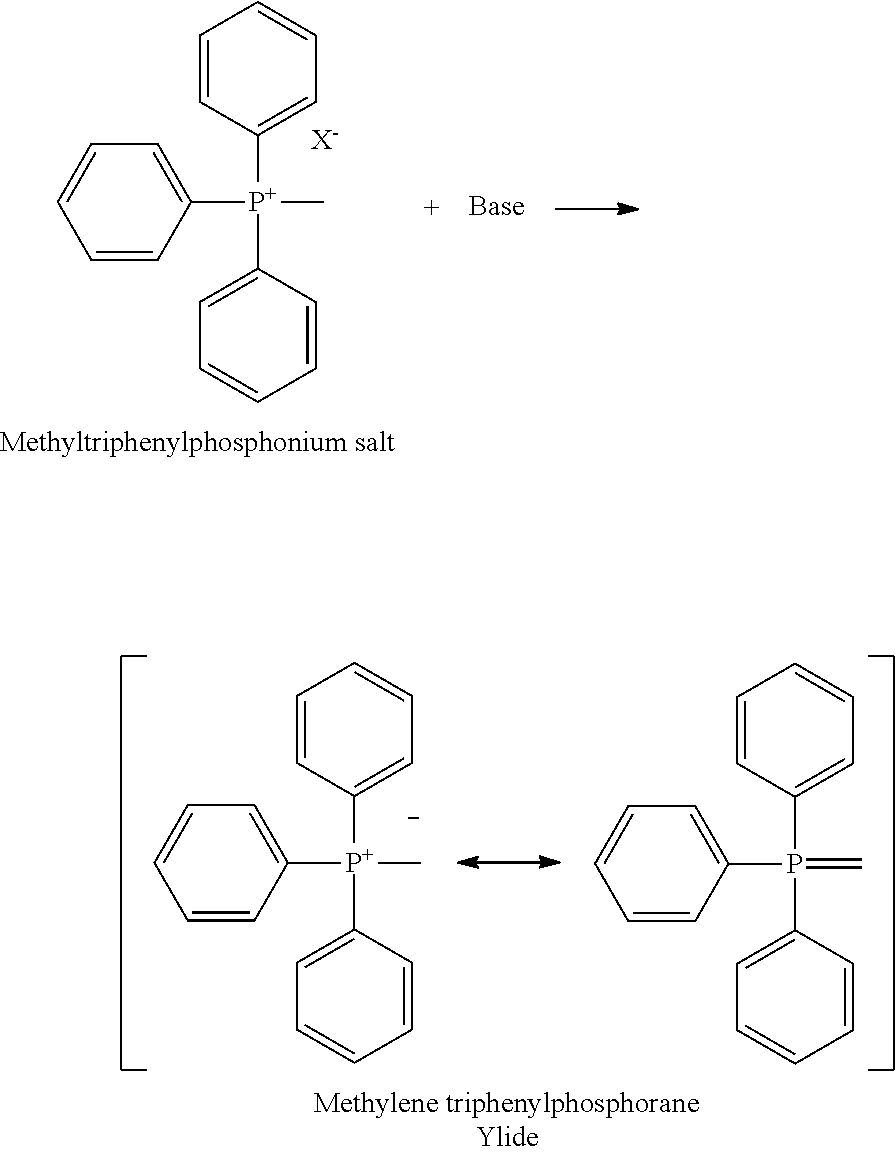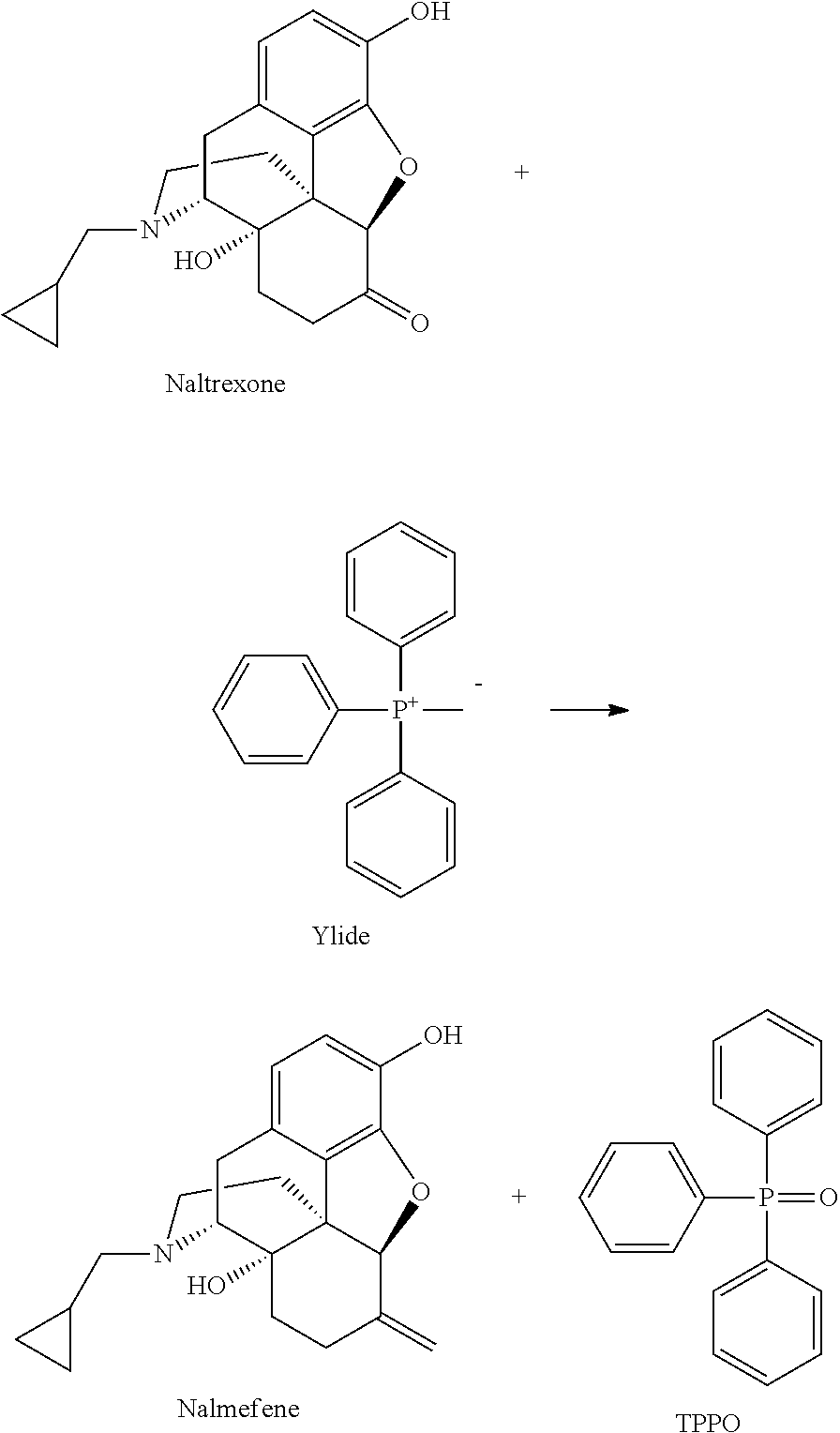Preparation of nalmefene hydrochloride from naltrexone
a technology of naltrexone and nalmefene, which is applied in the field of preparation of naltrexone nalmefene hydrochloride, can solve the problems of difficult industrial handling of the nah used to prepare the ylide, large amounts of phosphorus by-products to be removed, and unsatisfactory for industrial applications
- Summary
- Abstract
- Description
- Claims
- Application Information
AI Technical Summary
Benefits of technology
Problems solved by technology
Method used
Image
Examples
example 1
[0101]Methyltriphenylphosphonium bromide (MTPPB, 25.8 Kg) was suspended in 2-methyltetrahydrofuran (MTHF, 56 liters). Keeping the temperature in the range 20-25° C., KO-t-Bu (8.8 kg) was charged in portions under inert atmosphere in one hour. The suspension turned yellow and was stirred further for two hours. An anhydrous solution of naltrexone (8.0 Kg) in MTHF (32 liters) was then added over a period of one hour at 20-25° C. The suspension was maintained under stirring for a few hours to complete the reaction. The mixture was then treated with a solution of ammonium chloride (4.2 Kg) in water (30.4 liters) and then further diluted with water (30.4 liters). The phases were separated, the lower aqueous phase was discarded and the organic phase was washed twice with water (16 liters). The organic phase was concentrated to residue under vacuum and then diluted with dichloromethane (40 liters) to give a clear solution. Concentrated aqueous hydrochloric acid (HCl 37%, 2 liters) was added...
example 2
[0103]The procedure described in U.S. Pat. No. 4,751,307 was repeated, starting from 10 g of naltrexone and yielding 8.5 g of nalmefene. The isolated product showed the presence of phosphine oxides by-products above 15% molar as judged by 1HNMR.
example 3
[0104]Methyltriphenylphosphonium bromide (MTPPB, 112.9 g) was suspended in 2-methyltetrahydrofuran (MTHF, 245 ml). Keeping the temperature in the range 20-25° C., KO-t-Bu (38.7 g) was charged in portions under inert atmosphere in one hour. The suspension was stirred for two hours. An anhydrous solution of naltrexone (35 g) in MTHF (144 ml) was then added over a period of one hour at 20-25° C. The suspension was maintained under stirring overnight. The mixture was then treated with a solution of glacial acetic acid (17.7 g) in MTHF. Water was then added and the pH was adjusted to 9-10. The phases were separated, the lower aqueous phase was discarded and the organic phase was washed twice with water. The organic phase was concentrated to residue under vacuum and then diluted with dichloromethane (175 ml) to give a clear solution. Concentrated aqueous hydrochloric acid (HCl 37%, 10.1 g) was added over one hour at 20-25° C. The suspension was stirred and then filtered and washed with di...
PUM
| Property | Measurement | Unit |
|---|---|---|
| temperature | aaaaa | aaaaa |
| temperature | aaaaa | aaaaa |
| temperature | aaaaa | aaaaa |
Abstract
Description
Claims
Application Information
 Login to View More
Login to View More - R&D
- Intellectual Property
- Life Sciences
- Materials
- Tech Scout
- Unparalleled Data Quality
- Higher Quality Content
- 60% Fewer Hallucinations
Browse by: Latest US Patents, China's latest patents, Technical Efficacy Thesaurus, Application Domain, Technology Topic, Popular Technical Reports.
© 2025 PatSnap. All rights reserved.Legal|Privacy policy|Modern Slavery Act Transparency Statement|Sitemap|About US| Contact US: help@patsnap.com



